Single-circuit heating system - device layout and
No residential building can function normally without a climate system, thanks to which the rooms are comfortable for people to live in. Temperature. There is a huge number of different schemes, but the most simple and inexpensive is a single-circuit heating system, the design features of which will be discussed below.
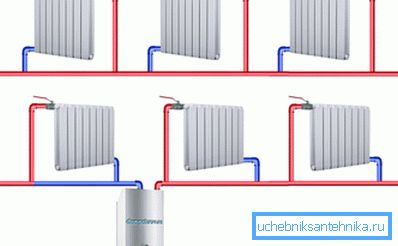
Description of the scheme
Constituent elements
Single-circuit heating is different from other piping layouts by the number of lines used. Here, one pipe is used to supply the coolant to the radiators and return the cooled liquid to the boiler.
Only conditionally it is divided into two sections:
- delivery line;
- return line (obratka).
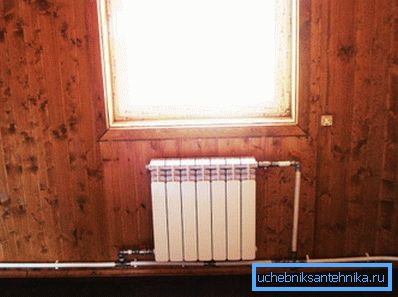
In addition to pipelines, the composition of the heating system under consideration includes the following components:
| Title | Description |
| Boiler | The main character. It is here that the thermal energy received from the combustion of fuel is transferred to the coolant (water or antifreeze). Then the liquid through the pipe enters the radiator, where the secondary exchange occurs - the heat of water through the walls of the batteries is transferred to the air and objects in the room. |
| Radiators | The main heat exchange equipment. They are installed in all rooms that need to be heated. Without them, it would be impossible to organize effective heat exchange, since the area of pipes is often not enough to heat the rooms. |
| Expansion tank | Required to compensate for the pressure in a closed heating system and the storage of water, which increases in volume when heated. There are open and closed. The latter are preferable, since they prevent evaporation of the coolant and can be installed anywhere in the system (and not only at its upper point). |
| Fittings | This includes all the other small in size, but no less important details: shut-off valves, thermal valves, Mayevsky taps, and so on. |
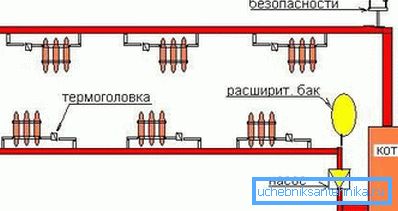
Note! There is a single-pipe heating circuit with natural circulation of fluid through the pipes and forced. In the latter case, an indispensable element of the mounted climate network is a circulation pump transferring the coolant.
Advantages and disadvantages
The described heating circuit works as follows: the heated liquid becomes less dense and lighter, therefore it is forced out with heavy cold water to the upper point of the heating system.
Then, cooling down, the coolant goes down, simultaneously flowing through all installed radiators and giving the accumulated heat to the air in the rooms. Therefore, batteries located closer to the boiler (or on the upper floors) heat better. This is one of the most serious shortcomings of single-circuit heating.
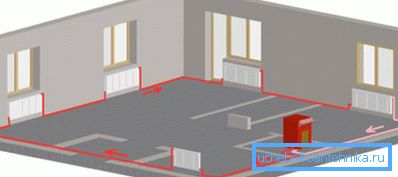
To compensate for the temperature difference, radiators located closer to the heater have a smaller heat exchanger area, while the farthest are constructed from a larger number of individual sections, which increases their power.
There are several ways to increase the efficiency of a single-circuit heating system:
- Installation of a circulation pump. In this case, the fluid flows through the heating devices more intensively, as a result of which the efficiency of the entire climate network is increased.
- Proper placement of radiators. To reduce heat loss, it is recommended to install batteries closest to the boiler in the warmest rooms — interior rooms with a minimum of windows — if possible.
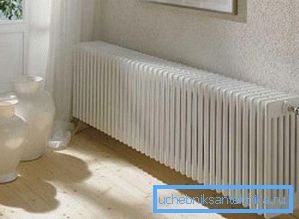
On the other hand, single-circuit heating is still quite popular.
It is widely used in individual construction, as it has many advantages:
- low cost of installation - for installation it is necessary to buy a minimum of pipes and other fittings, the costs for the services of installation crews are also reduced;
- more aesthetic appearance - since there is only one pipe, it is easier to hide, disguise or concreted into the wall (floor);
- the ability to select the flow of hot water - the inclusion of those or other circuits by using manual or automatic valves;
- the possibility of laying pipelines under the interior doors.
Note! The exact layout of the pipelines depends on the layout of the house. It is necessary to choose such places that guarantee the minimum amount of heat loss.
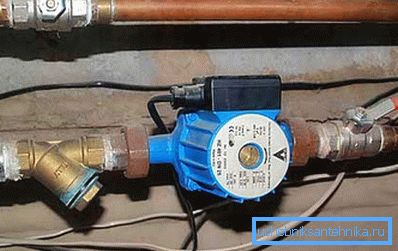
Remember that effective liquid flow in a natural way cannot be organized in such cases:
- the total area of the house exceeds 200 square meters;
- the length of the contour is more than 30 meters;
- more than 10 heating radiators are connected to one heating circuit.
In this case, you still have to install a circulating pump or buy a boiler already equipped with it.
Thermal calculation
The comfort in the rooms depends not only on the gasket layout, but also on the amount of heat energy that the batteries give to the air in the rooms. Therefore, in order not to freeze in the winter, you need to make the correct thermal calculation. This, by the way, is also indicated by the instruction enshrined in the current SNiP.
Thanks to the correct calculation, you can choose:
- the boiler of the necessary power - the weak will not be able to heat the house, the powerful will in vain burn expensive energy resources;
- radiators of the required area - this will help to significantly reduce the cost of their purchase.
Calculations can be made independently (using a special computer program) or contact a specialized engineering firm. The second option is more expensive, but so you will be sure of the correctness of the data provided to you.
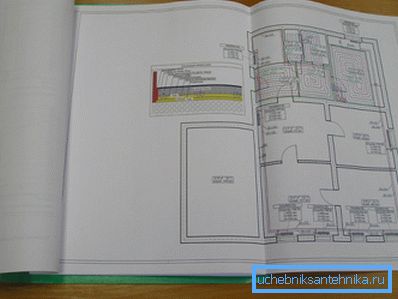
In addition, the engineers of this organization will prepare the scheme of the heating circuits, drawn on the provided plan of your house (apartment). This will greatly facilitate installation and help to buy the right amount of materials.
Varieties of single circuit schemes
Vertical wiring system
In this case, the heat carrier heated by the boiler rises along the vertically installed riser to the highest point of the heating network (to the attic or below the ceiling of the upper floor), from where it then flows downwards, heating the batteries located on each floor of the house.
Features of the design and operation of vertical heating circuits are as follows:
- the movement of the coolant can be provided in a natural way, without the use of electrical equipment;
- all pipe sections should be laid with a slight bias towards the boiler in order to increase the intensity of water circulation and to avoid the formation of air plugs;
- pipes are difficult to hide in the walls, as in this case you can hardly keep the slope;
- the system works completely autonomously, so even in the event of an emergency power cut, you will not be left without heat.
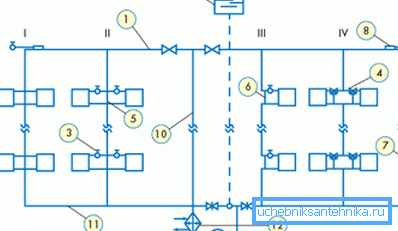
With horizontal wiring system
Here the vertical riser is not mounted. The main pipeline is conducted along the floor or under it. If you decide to disguise the pipes in the concrete screed, take care of their thermal insulation, otherwise you will not avoid quite significant heat loss.
In addition, it is desirable in this case to observe the bias:
- first, the heating network will be able to work (albeit less efficiently) in the event of a power outage;
- secondly, when filling pipes with liquid, you will avoid the formation of air tubes.

Ways to connect radiators
Here we will not consider the individual battery designs and placement options for pipes (bottom, side, and so on). Let us only on the eyeliner pipes. All options docking radiators are shown in the table.

| View | Description |
| Flow through | In this case, the heating circuit is connected to the inlet and outlet of the battery. Water flows through each radiator installed in the system, since there is simply no other way. Such a connection does not allow to adjust the intensity of the work of heating devices. In addition, in the case of leakage of heating devices, it is necessary to completely stop the heating system and drain the coolant. |
| Closing | Here the inlet and outlet of the battery are also connected to the bypass section of the pipe (the so-called bypass). It is necessary to take a part whose diameter is slightly smaller than the main supply circuit. The water entering the battery is divided into two streams: into the battery and into the bypass. By installing a thermal valve at the inlet, and at the output and bypass - valves, you can easily adjust the temperature in the rooms and replace the batteries without stopping the operation of general heating. |

Installation of single-circuit heating system
The construction of a climate network with one pipeline is performed in the following sequence:
- The boiler is installed. For obvious reasons, it should be mounted at the lowest point of the system. The greater the height difference between the radiator and the heater, the better the heat exchange in the system will be.

If you do not have the opportunity to install the unit in the basement, you need to equip it with a pit, cast from concrete and lined with ceramic tiles.
Note! If you decide to make a system with forced circulation, you can not resort to such tricks. However, by placing the heater in the manner described above, you will make the heating system more independent from utility networks.
- Mounted radiators. Here you need to strictly observe the horizontal and vertical, otherwise the batteries will accumulate mineral deposits, which sooner or later clog all the channels. Because of this, you will have to either clean or change devices.
You also need to keep the distance between the battery and the structural elements of the building. Violation of the battery hanging technology will cause air to circulate poorly around it. This will adversely affect the performance of the device.
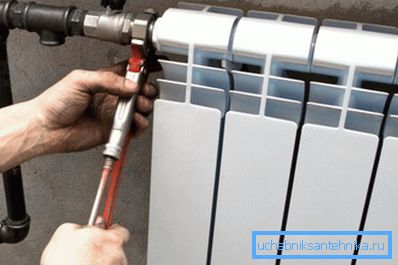
- Pipeline installation. Here you should decide on the material of the pipes. The most common climate network of polymer parts, however, if part of the system is a solid fuel boiler, it is better to prefer steel. The above unit heats the coolant to a temperature in excess of 95 degrees Celsius, which is very harmful for plastic pipes.

- Installation of additional elements. Electric pumps, control and regulating equipment, expansion tank, air valves and so on are mounted.
- Last stage of work - pressure testing. For its implementation, it is better to invite a qualified worker with a special pneumatic device.

Conclusion
Single-circuit heating system is a cheap and effective way to provide heat for small houses and apartments. However, if you own a penthouse or a huge estate outside the city, it is better to choose other options.
You can learn about them by reading the video in this material.